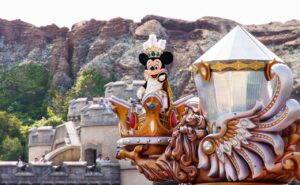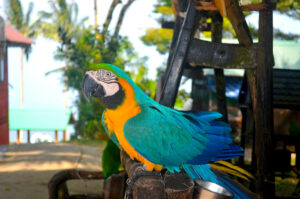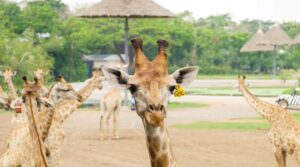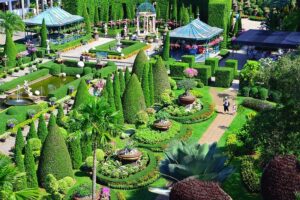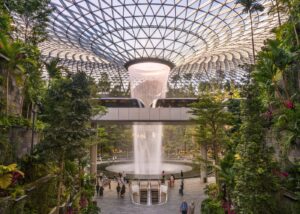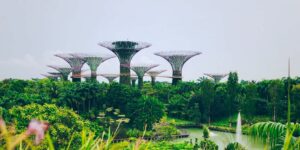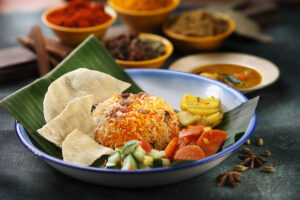In the western part of Singapore , on the jungle-covered Jurong Hill, there is a world-famous bird park, where over a million tourists visit each year. An area of 20 hectares has become home to more than 5,000 birds from all over the planet.
If you are interested in the birdlife, and you are curious to see how the female Australian ostrich emu lays huge eggs dotted with black dots, to hear the giggling of the Indian white-tufted mockingbird, you should definitely visit the Jurong Bird Park in Singapore.
You will hear the polyphony of its inhabitants and the guests who have flown to them long before entering this amazing corner of the country. This is another popular location among lovers of flora and fauna after Singapore Zoo.
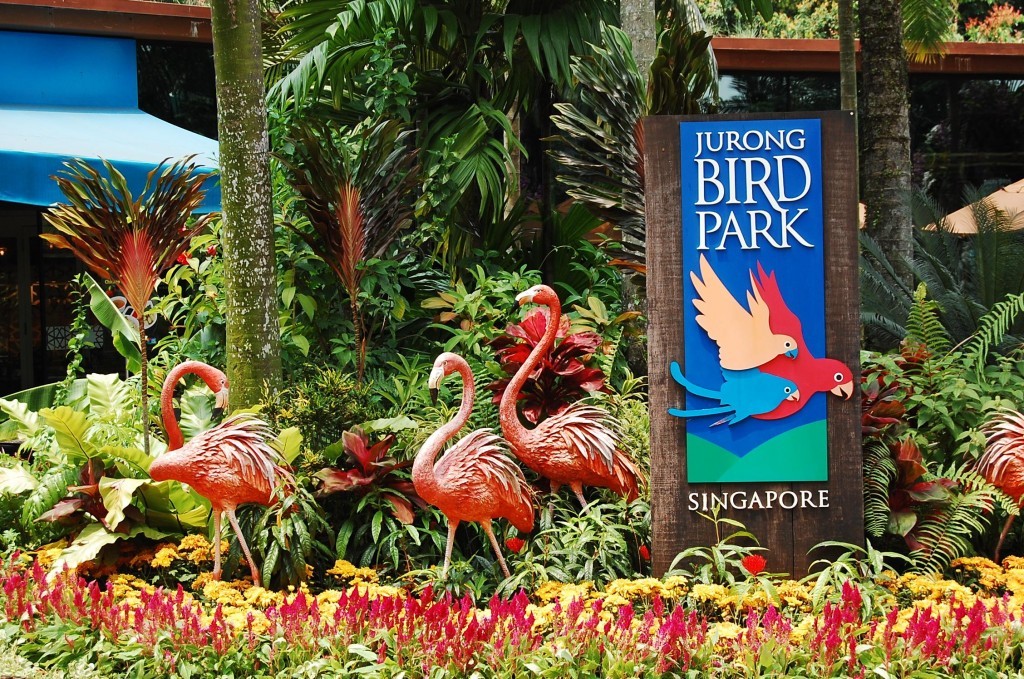
What to see in Jurong Park in Singapore
In a spacious pavilion with a height of a 12-storey building, tourists walk freely, observing the freely flying multicolored birds. Basically, representatives of the African fauna live here, but there are birds from Asian and Latin American countries.
Glossy blackbirds, long-tailed and forelock turaco, rock magpies with snow-white necks and more than 80 species of exotic inhabitants of the aviary feel at ease on 2 hectares of land covered with palm trees, bamboo and other various tropical trees.
Here, in the middle of a blossoming valley, streams of a man-made 30-meter waterfall break on the rock. Water flows sinuously, overcoming terraced levels, creating an ideal environment for fish, waterfowl and plants. Visitors can admire the spectacular landscape from a rickety suspension bridge.
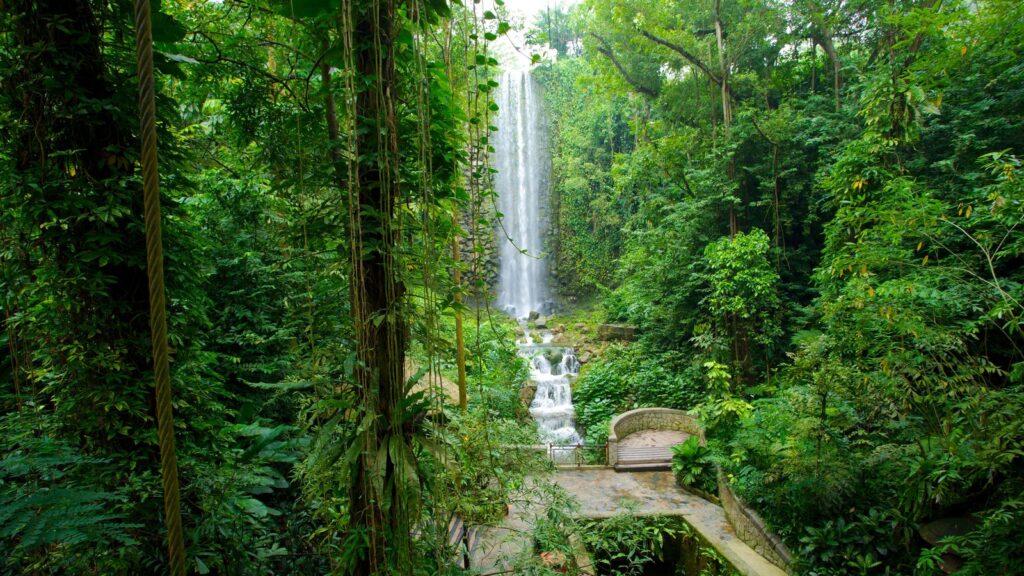
What birds are there in the park
Predator birds
Birds are some of the finest hunters on the planet. All visitors to Jurong Park in Singapore will be able to observe birds of prey in special enclosures or to be convinced of their hunting skills by attending the Kings of the Sky show, which takes place every day at the Hawk Arena. VIP excursions “At the height of a bird’s flight” are also available for guests. Tour participants will be able to watch birds of prey from above.
In the park, all guests can walk along the upper tier of the canopy to get acquainted with those birds that live at the height. Then go down to the lower tier and look at those birds that prefer to be closer to the ground.
Flamingo pool
This pool is home to the brightest species of flamingos – pink. This color of bird feathers is obtained due to the pigment that is contained in their food. Park workers monitor the diet of flamingos and add special pellets to the feed that maintain the pink color of the feathers.
Flamingos are real fashionistas in the world of birds. Most of their time, they preen themselves by peeling their feathers. Even the mating games of flamingos are similar to the rituals of cleansing the feathers, but performed in a more precise sequence.
Small flamingos also live in the pool. Their height is only 80-90 centimeters. This type is distinguished by a beak, which contains up to ten thousand mini-plates necessary for chewing food. There is also a pouch under the beak, similar to that of the pelicans. In this pouch, flamingos digest leftover food and store water.
Pink and lesser flamingos hardly come into contact, since their diets are different. This allows the birds to live comfortably in the same area.
Aviary with parrots and birds of paradise
The Jurong Bird Park in Singapore has another huge aviary, this space is “occupied” by parrots. Sociable lorises run here, but in the tropical valley other representatives of this order of birds also coexist with them. You can feed the birds with treats. Invite them to a photo session, they will willingly sit on your arms, shoulders or on a cap. Nearby, in the location of the Window of Paradise, birds of paradise live from Australia and New Guinea.
The parrot enclosure contains two rare species of these birds, both of which are listed in the local Red Data Book of Brazil. This is a hyacinth macaw and a golden kennel. They are adjacent to the endangered blue-throated macaw and red-faced macaw, which in the wild live only in Bolivia. Two species of cockatoo are considered no less rare – blue-eyed and salmon-crested cockatoo. They are also featured in Jurong Park.
Hint: Try to arrive at the bird park before 9 am. If you decide to feed the birds, then it is safe to say that you will not be left without their attention.
Feeding takes place near the waterfall, where representatives of different species of birds flock for breakfast. This is a great opportunity to take many unique photos.
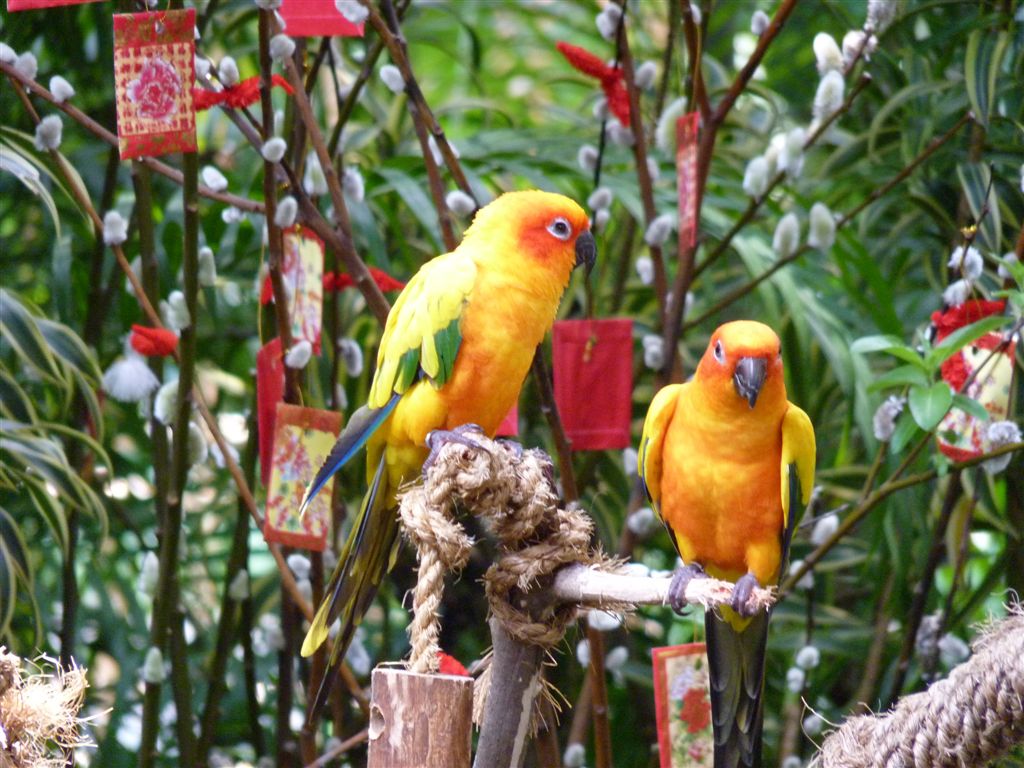
Penguins
A wooden sailboat imitating a Portuguese galleon rises right at the entrance to the Jurong Bird Park. This is the Penguin Coast location. At an altitude of 1600 meters, there is an indoor hall where two species of king penguins live. A constant temperature is maintained in this space, not exceeding +15 degrees. The zone is also equipped with a special lighting system that simulates the four seasons of the year. Such conditions allow penguins to feel comfortable even in hot Singapore. Two hundred funny penguins live in reservoirs surrounded by cliffs. Tourists watch them through the wide windows of the gallery.
Flamingos, pelicans, swans
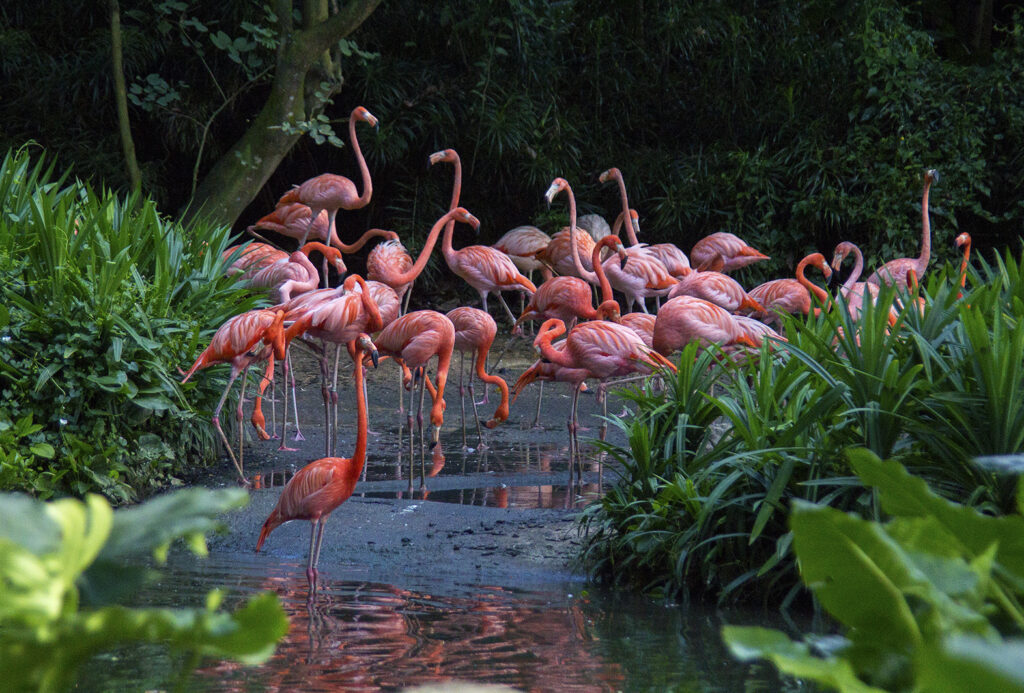
Nearby is the Flamingo Lake. The smallest species of flamingos live here. Flamingo Lake in Jurong Park is a unique place. Here you can watch flamingos chicks grow. Flamingo chicks are white in color, and they feed on mother’s milk. This is surprising, since only two species of birds feed their chicks with milk. There is a red pigment in milk, which turns flamingos pink.
Jurong Bird Park contains a large collection of pelicans. The Dalmatian pelican, the largest of the existing species, lives here. As well as brown, American white, African pink, Asian spotted and Australian pelicans. All these species can be viewed in the world’s first underwater pelican viewing gallery.
After visiting the gallery, you can walk along the deck, which offers a beautiful view of the lake. You will notice large clusters of branches all over the water. These are pelican nests that they build for the whole community to live there. And if you visit the park during the bird breeding season, you can watch the construction in real time.
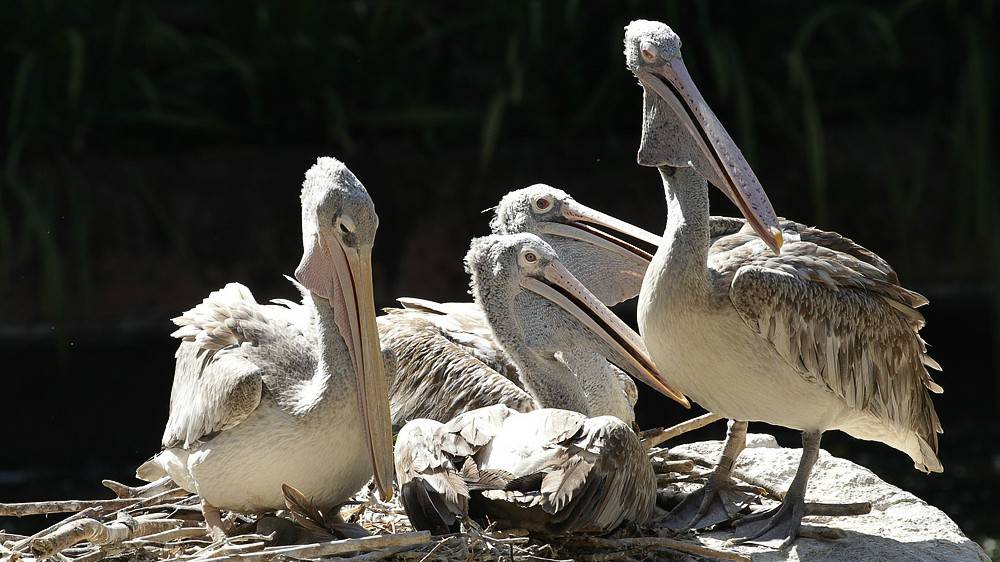
The park itself looks more like a tropical forest, in which various feathered inhabitants live in full life. For example, Guinean birds, bright as parrots, roam carelessly along forest paths, and starlings and other inhabitants of the park with no less bright colors build their nests on the tops of trees. You can see all the birds together during feeding hours, when the inhabitants of Jurong flock to the feeders to feast on worms, flies or fruits.
Wetlands
Many of us have hardly heard of such birds as ibis, spoonbills and others. These species are endangered and depend on wetlands for their survival. Their existence is important for the life of animals, birds and humans. Jurong Park is one of the few places where they try to recreate the conditions for the survival and reproduction of these species.
Another ecological topic that is revealed in Jurong Park is the conservation of wetlands. Such an area not only serves as a home for a huge number of birds and animals, but is also necessary to provide people with fresh water, medicinal herbs and other raw materials.
Unfortunately, now such locations have become one of the fastest disappearing due to the fact that most of the industries in agriculture and fisheries are located in wetlands. The park has recreated an area that mimics the wild nature of a swampy area.
Scientists and specialists have devoted a lot of time to the selection of plants that form the basis of the landscape of this zone, and also created an artificial surf that clears the “coast” from the accumulation of algae. In this area, you can especially often meet pelicans, who like to come here during the surf to “ride” the wave.
Jurong Bird Park Walkthrough Video
Nearby there is an area where toucans and rhino birds are located. Although the birds were brought from different parts of the world, they coexist perfectly. Guests of the park can observe twelve species of unusual hornbill birds. At the same time, Jurong is the only park that breeds black rhino birds. Very often these birds are confused with toucans, but in fact they are completely different species. These birds are similar only in the shape of the beak. While toucans are found in Central and South America, rhinos are found in sub-Saharan Africa and Asia, with one species in New Guinea. Hornbills and toucans are kept together in the park as they have similar eating habits.
There is also Swan Lake in the bird park of Singapore, where black-necked, black swans, whooper swans live. The lake is adjacent to the Bay of Pelicans. Birds from Asia, Australia and the USA live here.
While visiting Jurong Bird Park, look out for the Santa Cruz Earth Dove from the Solomon Islands. This bird is endangered. Now the park contains about 60 representatives of the species, which is half of the population.
Wings of asia
The area of the park called “Wings of Asia” is located on an area of 2600 square meters. This is the largest exhibition of birds that live in Continental and Southeast Asia. There are now 24 endangered bird species in Asia. Eleven of these views await you at Jurong Park. Here you can see the Javanese Green Magpie, the Formosan Laughing Thrush and the Racket-Tailed Parrot.
The novelty of the park is a goose brought from the sterile cape. First spotted by researchers on Cape Barren Island, this bird is also known as the “swine goose” due to its low, pig-like chirping grunt. You can get a closer look at the goose right at the entrance to the “Wings of Asia” zone.
Research Center
The main task of the Jurong Bird Park is to preserve endangered bird species. This center was created for this. Here they help to feed and raise chicks. In the center there is an incubator, visitors are told what stages they go through until a chick hatches from an egg. Then he goes to the “nursery”, where he is fed every two to three hours.
Shows and activities in Jurong Park
Twice a day, at 11:00 and 15:00, Jurong Park hosts bird shows. Cost 25 SGD for adults and 20 SGD for children. The High Flyers Show features pelicans, flamingos, hornbills. The stars of the Kings of the Skies Show are eagles, hawks, falcons, condors. Their dwelling is located in a separate aviary for flying predators.

On the Songbird Terrace, you can dine twice a day while watching a 30-minute parrot performance. At other times, guests at tables on the shore of the lake are delighted with the trills of a Chinese nightingale to the accompaniment of the sound of hectic magpies. At the exit from the park, there is an extensive children’s area with water park attractions.
Opening hours, ticket prices
Jurong Bird Park in Singapore operates daily from 08:30 to 18:00. Tickets cost 28 SGD for adults and 18 SGD for children. For 5 SGD you can ride through the park in an air-conditioned tram car. It runs on a panoramic monorail. There are also package tickets that include other parks and gardens in Singapore besides Jurong. For example, Gardens by the Bay and Butterfly Park , but it is unlikely that you will be able to inspect several locations at once.
Buy tickets with discount to Jurong Bird Park on Viator.

How to get to Jurong Park
When choosing how to get to the Singapore Bird Park, give preference to taxi or metro. A taxi ride from the city center will take about half an hour. Take the subway longer: you need to get to Boon Lay station. Then change to bus no. 194 or 251 and continue to the next stop.
You can also book a Bird’s Eye Tour. On this tour, guests are encouraged to see a little more. For example, see how the chicks are fed, feed the hornbills, vultures, owls).


